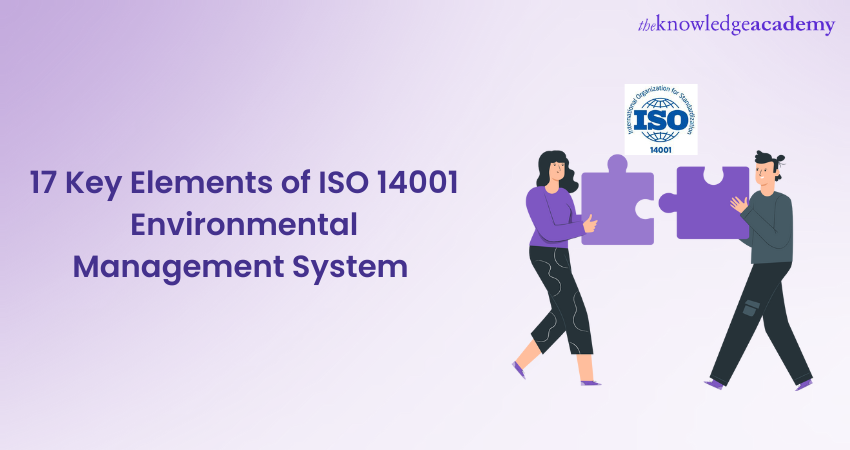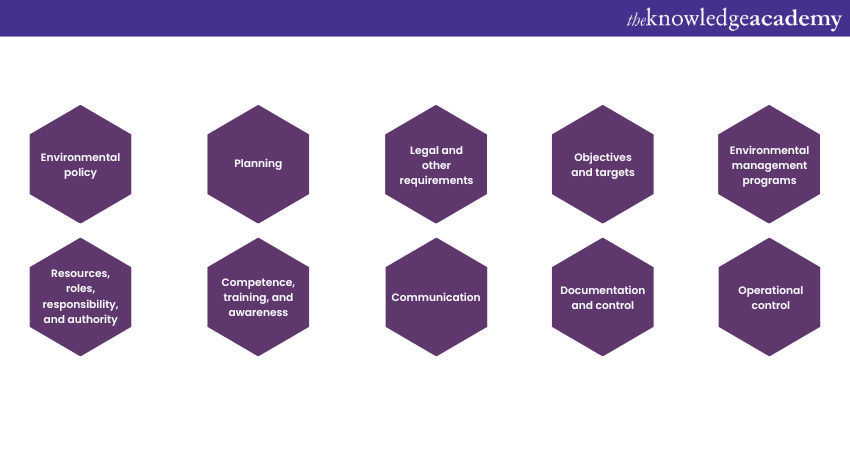We may not have the course you’re looking for. If you enquire or give us a call on 01344203999 and speak to our training experts, we may still be able to help with your training requirements.
Training Outcomes Within Your Budget!
We ensure quality, budget-alignment, and timely delivery by our expert instructors.

When it comes to effectively managing environmental responsibilities, organisations worldwide turn to ISO 14001. However, before implementing the standard for Environmental Management Systems (EMS), it is crucial to understand the Elements of ISO 14001. These elements form a framework that helps organisations manage their environmental responsibilities effectively including the identification and consideration of ISO 14001 Risks and Opportunities for a comprehensive approach.
According to the 2022 ISO Survey of Management Systems, there are over 400,000 ISO 14001 certificates spanning over 600,000 sites. Furthermore, companies can demonstrate their commitment to environmental sustainability and improve their environmental performance by implementing the ISO 14001 standard. Organisations recognise the importance of considering the ISO 14001 Context of the organisation who want to become certified and enhance the effectiveness of their EMS should check out the 17 Key Elements of ISO 14001 discussed in this blog.
Table of Contents
1) Overview of the ISO 14001
2) 17 Elements of the ISO 14001
3) Conclusion
Overview of the ISO 14001
ISO 14001 Version 2004 vs 2015 is an internationally recognised Environmental Management Systems (EMS) standard. It provides organisations with a structured framework to effectively manage their environmental responsibilities. ISO 14001 software enhances the efficiency of managing environmental responsibilities within this framework. By implementing ISO 14001 within the ISO 14001 Life Cycle companies can establish policies, objectives, and targets for improving their environmental performance.
Furthermore, the standard requires organisations to identify and comply with applicable environmental laws and regulations, conduct regular audits, and take corrective actions when necessary. ISO 14001 promotes continuous improvement in Environmental Management by emphasising aspects such as resource allocation, training, communication, and emergency preparedness. Achieving ISO 14001 Certification demonstrates a company's commitment to sustainable practices and enhances its reputation in the market.

17 Elements of the ISO 14001
ISO 14001 consists of 17 key elements that form the foundation of an effective Environmental Management System. These elements ensure that organisations effectively manage their environmental responsibilities, drive continuous improvement, and demonstrate their commitment to sustainable practices. Here are the elements described as follows:

1) Environmental policy: The environmental policy sets the overall direction and commitment of the organisation towards environmental sustainability. It outlines the organisation's objectives and targets for environmental performance.
2) Planning: This element involves identifying environmental aspects, assessing impacts, and defining objectives and targets to address significant environmental issues. It includes establishing action plans and allocating resources accordingly.
3) Legal and other requirements: Organisations must identify and comply with applicable environmental laws, regulations, and other requirements relevant to their activities, products, and services.
4) Objectives and targets: Establishing measurable objectives and targets aligned with the organisation's environmental policy helps drive continuous improvement in environmental performance.
5) Environmental Management programs: Organisations develop and implement programs to achieve their environmental objectives and targets effectively. These programs include defining responsibilities, timelines, and performance indicators.
6) Resources, roles, responsibilities, and authority: Clearly defining roles, responsibilities, and authorities related to Environmental Management ensures effective implementation of the EMS. Adequate resources, both human and financial, must be allocated for its successful operation.
7) Competence, training, and awareness: Organisations need to ensure that personnel working within the EMS have the necessary knowledge, skills, and awareness of environmental issues to perform their tasks effectively.
8) Communication: Establishing effective internal and external communication channels facilitates the exchange of environmental information, including environmental policies, objectives, and performance results.
9) Documentation and control: Organisations must maintain documented information to ensure the effective operation of the EMS. This includes procedures, work instructions, and records related to Environmental Management.
10) Operational control: Implementing controls and procedures to manage operations that can significantly impact the environment is crucial. This element ensures compliance with environmental requirements during routine activities.
11) Emergency preparedness and response: Organisations must identify potential environmental emergencies, develop response procedures, and conduct drills to ensure prompt and effective action during crises.
12) Monitoring and measurement: Regular monitoring and measurement of key environmental indicators provide data for evaluating the performance of the EMS, identifying trends, and implementing corrective actions.
13) Evaluation of compliance: Organisations need to assess their compliance with applicable environmental laws and emphasising the importance of ISO 14001 Compliance for effective environmental management regulations to identify gaps and take appropriate corrective measures.
14) Nonconformity, corrective action, and preventive action: When deviations from planned procedures or nonconformities occur, organisations must investigate the root causes, take corrective actions, and implement measures to prevent recurrence.
15) Control of records: Establishing a robust record-keeping system ensures the availability and integrity of Environmental Management-related records for future reference and audits.
16) Internal audit: Regular ISO 14001 internal audits evaluate the EMS's effectiveness, identify improvement areas, and verify compliance with ISO 14001 requirements.
17) Management review: Top management conducts periodic reviews to ensure the EMS's continued suitability, adequacy, and effectiveness. This review includes assessing opportunities for improvement and making necessary changes.
Enhanced market competitiveness is achieved through environmental responsibility, in line with updated ISO 14001:2015 standards emphasising sustainable practices."
Apply ISO principles within your organisation by signing up for the ISO 14001 Foundation Course now!
Conclusion
The 17 Key Elements of ISO 14001, outlined in this blog, provide a comprehensive framework for building a successful Environmental Management System. Implementing ISO 14001 helps organisations adopt a systematic approach to Environmental Management. With this framework, companies can enhance their environmental performance, comply with legal requirements, and demonstrate their commitment to sustainability to stakeholders and customers.
Implement ISO principles to acquire environmentally friendly organisational standards by signing up for ISO 14001 Training Courses now!
Frequently Asked Questions
Upcoming Health & Safety Resources Batches & Dates
Date
 ISO 14001 Foundation Certification
ISO 14001 Foundation Certification
Mon 17th Jun 2024
Mon 21st Oct 2024
Mon 6th Jan 2025
Mon 7th Apr 2025
Mon 4th Aug 2025
Mon 3rd Nov 2025







 Top Rated Course
Top Rated Course


 If you wish to make any changes to your course, please
If you wish to make any changes to your course, please


